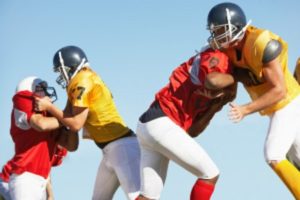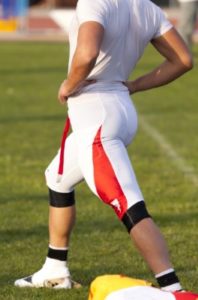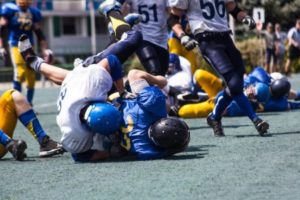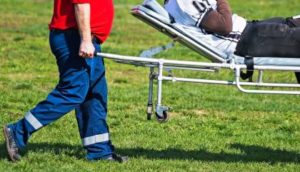Does your teenage son play high school football?
If so, the odds are high that he will sustain some kind of injury at some point during his four years of playing. Research has shown that football is the leading cause of school sports injuries across the country. According to the National High School Sports—Related Injury Surveillance Study, a high school football player is three times more likely to become injured than competitors in other major sports. It’s also more likely an injury will occur during a game instead of practice. In 2015-16, 568,789 high school athletes were treated for football-related injuries. The most common of these injuries included strains and sprains. Injuries to the knees, ankles and shoulders were among the most common areas of the body where injuries occur.
This should not come as a surprise to anyone. After all, as an incredibly high contact sport, football has a dangerous propensity and natural tendency to inflict injury.
However, you and your child’s coaches can take steps to safeguard him from getting hurt.
Here are six tips to help your son avoid getting a sports injury.
- Warm up and stretch.
Many high school sports programs today emphasize strengthening exercises but not stretching. It’s critical to stretch to allow your body to become more flexible.
Take the time to warm up and stretch your hips, knees, thighs, and calves before lifting and prior to every practice and game. Studies have shown that cold muscles are more prone to an injury.
You can warm up with jumping jacks as well as running or walking in place for five minutes. Then slowly and gently stretch, holding each stretch for 30 seconds.
- Cool down and stretch.
Stretching after practice and a game is just as important. Few players stretch at the end of practice often because of their busy schedules.
But stretching after practice and even after a game can help reduce muscle soreness and keep muscles long and flexible.
Be sure to stretch after each practice and game to reduce your risk for injury.
- Hydrate and hydrate some more.
As an athlete, you want to avoid dehydration. If you don’t drink enough fluids, your body will be unable to cool itself through sweat and evaporation. Plain old water or even a sports drink is the best way to go; it will prevent your body from overheating.
Drink about 24 ounces two hours before exercise or the start of practice or game. While you are exercising or during practice or a game, aim to drink about 8 ounces of water every 20 minutes.
- Improve Proprioception
Proprioception is your body’s innate ability to determine where all of its parts are positioned at any given time. Think of it as a “position sense” or even a “sixth sense.” Running without watching your feet or throwing a football without looking at your arm are examples of proprioception.
One way your child can improve his proprioception is by standing on one leg and closing his eyes. He can start out with 20 seconds, and then increase it up to one minute as he becomes more comfortable.
Another good proprioception exercise is to add body movements while he is in a single leg stance. Have him play catch with a football while balancing. This activity forces his body to adapt and improves his proprioception and balance. As he moves, the muscles in his foot, ankle, and leg have to adapt to the different stresses to keep his balance.
- Condition Properly
Many football-related injuries can be avoided by making sure your child has a good grounding in building physical conditioning.
Be sure your son is in top physical condition at the start of football season. Working out before the season is important so that your child doesn’t work too hard, too soon.
The American Academy of Orthopaedic Surgeons recommends that during the off-season, your son stick to a balanced fitness program that incorporates aerobic exercise, strength training, and flexibility. If your child is out of shape at the start of the season, have him gradually increase his activity level and slowly build back up to a higher fitness level.
- Practice falling down
Knowing how to fall and roll can minimize some of the more severe injuries your son can suffer on the field.
Falling poses a serious risk of injury and the severity of those injuries vary.
For instance, falling directly on your back can cause serious injury to it.
One technique your child can use to help reduce the impact and prevent an injury from a fall is to turn his body so he lands on his side. By landing on his side, he can reduce the chance of injury to his head, face, and arms.
Treating an injury
Any pain your young athlete complains about needs to be addressed immediately. If your son suffers an injury to his knees, ankles, or shoulders, the best thing he can do to relieve the pain is with ice packs. You can apply ice multiple times a day for 20-minute periods.
Rest is also important. Be sure your son rests his body after an injury. For at least a few days after the injury occurs, he should limit his activity and get as much rest possible while elevating the affected area.
Finally, no matter how minor the injury may seem at first, never let it go for more than three days without seeking medical attention. Don’t go to the emergency room or an urgent care—go to an orthopedic surgeon who can diagnose the injury more accurately.
Dr. Lawrence Li and the staff at Orthopedic & Shoulder Center know how to deal with many different types of injuries on the gridiron and we will do our very best to help your child get better so he can get back onto the field again.




